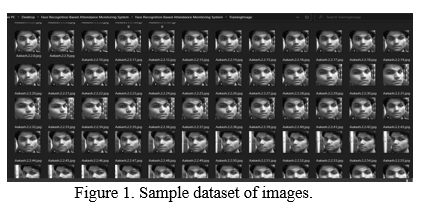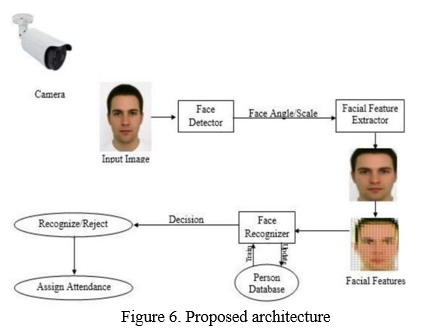Ijraset Journal For Research in Applied Science and Engineering Technology
- Home / Ijraset
- On This Page
- Abstract
- Introduction
- Conclusion
- References
- Copyright
Artificial Intelligence based Student Absenteeism Detector
Authors: Parth Mishra, Aakash Shukla, Gagan Chadha, Dr. Vasudha Vashisht
DOI Link: https://doi.org/10.22214/ijraset.2022.40540
Certificate: View Certificate
Abstract
The whole procedure of marking attendance in a classroom full of students can be a burdensome as well as time-consuming task at times. Presence of students in a substantial amount during the lecture increases the chances of botching the attendance. Moreover, after the pandemic hit of covid-19, all the safety measures and concerns will prove previously existing conventional methods of attendance marking to be very inefficient and unmethodical. On these grounds, marking of attendance with standard approaches has been a region of dispute. Demand of effective and automated methods to produce a8n attendance management system has been expanding recently. Recently, the trouble of automated attendance marking has been a wide concern using basic biometric info like fingerprint and RFID Tags (Radio Frequency Identification) etc. Conventional attendance checking methods for example pen and paper or attendance sheet signing are not difficult to sidestep and deceive as giving proxies or fake signature is a typical and common practice among students these days, students pull an unfair advantage mostly due to this. However, in any case, a facial recognition framework is unassailable and cannot be tricked as every individual has a set of exclusive and individual features restricted to that individual only and cannot be simulated or altered, everything boils down to one basic rule that is, except if you are actually present in the lecture your participation won\'t get acknowledged.
Introduction
I. INTRODUCTION
Artificial Intelligence and Machine Learning is one among many domains that enables us to automate the task of taking attendance through training an Artificial Intelligence model. We have tried to implement this domain in our AI based Student Absenteeism Detector, or Smart Attendance System, where we automatically estimate the presence or the absence of the student in the classroom by using face detection and classification technology. In our model, Viola-Jones Algorithm has been used f2or face detection and a Convoluted Neural Network has been made using Keras Library in order to classify those detected faces. The suggested project consists of four phases; Face capture, Face detection, Image Classification and Database update.
Compared to previous existing methods of attendance surveillance, we hope implementation of this system utilizing facial recognition technology will prove to be very efficient, accordingly reduce workload of people, and eradicate all the safety concerns of COVID. Instead of boorishly taking roll- calls and manually feeding attendance, our Smart Attendance System helps in increasing the accuracy and speed, finally helping us to achieve high-precision real-time attendance automatically.
II. RELATED WORK
There are plenty of applications as well as systems that are directly associated to the idea of face recognition technique that we have implemented in our project. In order to study more about these systems, we have undergone through the documentation and working of different such projects..
One of such systems that we came across was Apple’s FaceID, which is one of the very advanced and innovative hardware/software that has been ever created. The TrueDepth camera catches exact face information by deducing and dissecting large number of undetectable spots to make a ‘depth map’ of the human face and furthermore catches an infrared picture of the face.
Face Recognition applications for Mobiles, similar to the one proposed by FaceFirst, are now helping cops by assisting them with instantaneously recognizing people in the field from a protected distance.
Human Genome Institute Research Institute utilizes face detection to distinguish an uncommon sickness called DiGeorge disorder, in which a part of the 22nd chromosome is missing. As these algorithms get more refined, face detection will turn into a significant analytic instrument for a wide variety of situations.
III. EXISTING SYSTEM
Conventional attendance checking methods f1o4r example pen and paper or attendance sheet signing are not difficult to sidestep and deceive as giving proxies or fake signature is a typical and common practice among students these days, students pull an unfair advantage mostly due to this. However, in any case, a facial recognition framework is unassailable and cannot be tricked as every individual has a set of exclusive and individual features restricted to that individual only and cannot be simulated or altered, everything boils down to one basic rule that is, except if you are actually present in the lecture your participation won't get acknowledged.

IV. METHODOLOGY
This section mainly consists of the techniques and their working that is relevant to our project. The project has been separated into three main parts; Image detection, Image Classification and Attendance Marking. Our project also consists of GUI Creation, more about which is explained ahead.
A. Primary Database Creation
Our database comprises of pictures of different students whose attendances have to be marked Extraction of this dataset is done by students; they’ll have to carry out a one-time procedure of letting our application click the image of their face, which will be stored in our database.
Figure 1shows a glimpse of the dataset.

B. Image Detection Technique
The image detection technique we are implementing is Haar Cascade Algorithm or also known by the name Viola Jones Algorithm, kept on its creators Viola and Jones. It works by getting particular faces of the students and obtaining the distinctive features of their face (lips, nose, ears, eyes) by implementing edge detection features and line detection features. An example output for the working demonstration of this algorithm is shown in Figure 2, where face detection is being carried out:

The Haar cascade algorithm mainly works by providing us the components of the face that are required most for detection, that is, the Region of Interest and handling as well as cropping out other areas of the face that does not have a role in the image detection & classification. Once the faces are found they are isolated and stored.
C. Image Detection Technique
The image detection we’ll be using belongs to the OpenCV library and it is called cv2 LBPH Face Recognizer. It works on the algorithm called Local binary Patterns Histogram which is known for its performance and how it is able to recognize the face of a person from both front face and side face.


D. Attendance Marking
During the final stage of attendance marking, if detected image is similar to the image kept in the record, then the attendance is given successfully for that particular lecture, but in case any student goes unrecognized then a signal is popped up for the admin and the same is recorded in the database (excel file).

E. GUI Creation and Testing
After the creation of our AI Model, we have thought of implementing our system in a GUI created through Tkinter. Tkinter is a GUI widgets toolkit and one of the most powerful as well as popular cross-platform GUI library.
After completing the application and a series of functional as well as non-functional testing, our final proposed application will be created.
V. PROPOSED ARCHITECTURE
The architecture for the proposed system has been designed to keep it pretty straightforward and easy to understand. The steps that have to be undertaken to reach the final end step of the system which is making sure the attendance of the student is updated correctly and timely. The system can easily be accessed by anyone, where attendance of the students can easily be checked and maintained by the faculty as when required. OpenCV-Python will be used to access the LBPH and Haar Cascade algorithms.

A little insight on all the algorithms and techniques we are using in our project:
- Haar Cascade: The image detection technique we are implementing is Haar Cascade Algorithm or also known by the name Viola Jones Algorithm, kept on its creators Viola and Jones. It works by getting particular faces of the students and obtaining the distinctive features of their face (lips, nose, ears, eyes) by implementing edge detection features and line detection features.
- Local Binary Pattern Histogram: The image detection we’ll be using belongs to the OpenCV library and it is called cv2 LBPH Face Recognizer. It works on the algorithm called Local binary Patterns Histogram which is known for its performance and how it is able to recognize the face of a person from both front face and side face.
Local Binary Pattern (LBP) is a highly accurate surface descriptor for pictures which limits the adjoining pixels in view of the worth of the current pixel. LBP descriptors productively catch the nearby spatial patterns and the gray scale contrast in a picture.
VI. BENEFITS OF THE PROPOSED SYSTEM
There is a plethora of benefits which our proposed system offers, some of them have been mentioned in the Introduction part. The main features are listed below:
- Foolproof: Attendance checking becomes secure in nature, students can't carry out past methods for bogus attendance for their classmates as the framework needs faces of the students and that's it.
- Time Saving: The traditional way of marking attendance usually takes 5-10 minutes of the class depending upon the strength of the class. This doesn’t only consume time but also breaks the teaching flow. Our proposed system only requires clicking of a picture which takes hardly 30 seconds.
- Efficient: Rather than instructors physically uploading attendance to the school/college servers, the framework will itself work out attendance of students ahead of time.
- COVID Friendly: Future work consists of adding a mask detection feature as well a temperature detection system via infrared ray’s detection.
VII. FURTHER WORK
In order to complete our project and also improve the functionality and reliability of the system in the future, we can add some of the following enhancements:
- Completing the training of our AI Model and compiling all the individual AI Models in a final application or a GUI made using Tkinter. This will help us create the final application and mark the end of our project.
- Training our model to recognize if the student is wearing a mask or not, and using an Arduino to detect the temperature of the student through infrared rays, making our system COVID friendly.
- Adding a self-generating defaulter list, that is created after a certain amount of fixed time has passed for any student whose attendance is below required percentage.
Conclusion
This report gives us a complex but efficient methodology to calculate the attendance in a class by using facial detection and other AI methods. The yield of this system can be seen as follows: 1) As seen in figure 2, the system detects facial features of the students successfully, and from figure 5 we can derive it is successfully marking the attendance of students present in the excel file. 2) Also the accuracy from figure 3 says that the model is very precise in classifying images and the techniques chosen by us can successfully execute the desired aim. We wish to execute an efficient, time saving and simple to control system which will in turn benefit both faculty and students, and from the progress we have had so far it is highly probable that we will successfully build such a system. Although the work is 80% done, there still is some work left which will be completed by the time we have to demonstrate the project, the work being AI Model testing and GUI Creation, then overall final structural and functional testing.
References
[1] Radhika C.Damale, Prof.Bageshree.V.Pathak.“Face Recognition Based Attendance System Using Machine Learning Algorithms.\" Proceedings of the Second In- ternational Conference on Intelligent Computing and Control Systems (ICICCS 2018) IEEE Xplore Compli- ant Part Number: CFP18K74-ART; ISBN:978-1-5386- 2842-3. IEEE 2018 [2] Omar Abdul, Rhman Salim, Rashidah Funke Olan- rewaju, Wasiu Adebayo Balogun. “ Class Attendance Management System Using Face Recognition.\" 2018 7th International Conference on Computer and Com- munication Engineering (ICCCE) IEEE 2018. [3] Adrian Rhesa Septian Siswanto, Anto Satriyo Nu- groho, Maulahikmah Galinium. “Implementation of Face Recognition Algorithm for Biometrics Based Time Attendance System\" Center for Information Communi- cation Technology Agency for the Assessment Appli- cation of Technology (PTIK-BPPT) Teknologi 3 BId., 3F, PUSPIPTEK Serpong, Tangerang, INDONESIA, 15314.Jinsu Kim, Usman Cheema, Seungbin Moon. “,Face Recognition Enhancement by Employing Facial Component Classification and Reducing the Candidate Gallery Set. Department of Computer Engineer- ing, Sejong University, Seoul, 143-747, Korea (sb- moon@sejong.ac.kr). [4] Nusrat Mubin Ara, Nishikanto Sarkar Simul, Md. Saiful Islam.“ \"Convolutional Neural Network(CNN) Approach for Vision Based Student Recognition System.\" 2017 20th International Conference of Computer and Information Technology (ICCIT), 22-24 Decem- ber, 2017.
Copyright
Copyright © 2022 Parth Mishra, Aakash Shukla, Gagan Chadha, Dr. Vasudha Vashisht. This is an open access article distributed under the Creative Commons Attribution License, which permits unrestricted use, distribution, and reproduction in any medium, provided the original work is properly cited.

Download Paper
Paper Id : IJRASET40540
Publish Date : 2022-02-27
ISSN : 2321-9653
Publisher Name : IJRASET
DOI Link : Click Here
 Submit Paper Online
Submit Paper Online

